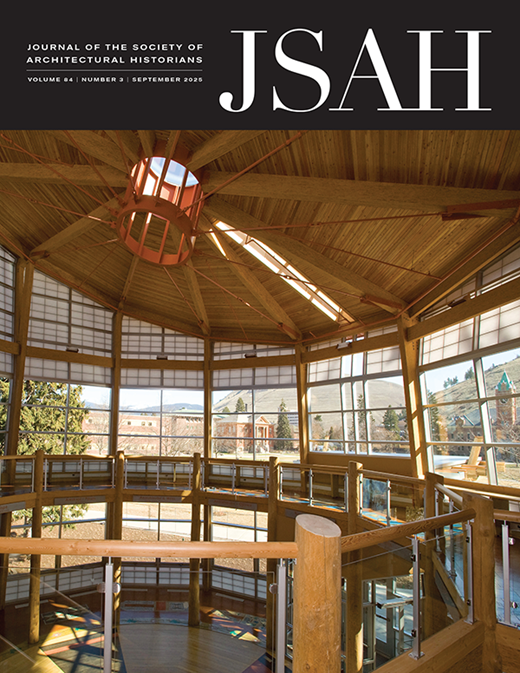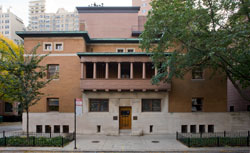Oct 16, 2025
by
SAH Heritage Conservation Committee
The Society of Architectural Historians (SAH) expresses great concern over the proposed ballroom addition to the White House. On July 31, 2025, the White issued a statement that a 90,000 sq. ft. addition will be made to the White House to incorporate a 650-person capacity ballroom.1 The project is set to begin in September 2025 and planned to be completed “long before” the end of the President’s term in 2029.2 Funded privately by the President and other unspecified donors, the approximately $200 million dollar project involves a major expansion of the East Wing of the White House.3
As the leading scholarly organization for architectural historians in North America, SAH limits its advocacy to matters of national and international import. We assess such issues with rigor and deliberation, and do not speak without due consideration of a site’s architectural and cultural significance. The White House is one of the most important historic buildings in the United States. As stated in the ‘Design Guidelines for the White House and President’s Park’ (1997), issued by the National Park Service: “The White House and President’s Park are first and foremost a public trust, an important part of our national heritage.” 4
While we recognize that the White House is a building with evolving needs, and that it has undergone various exterior and interior modifications since construction began in 1792, the proposed ballroom will be the first major change to its exterior appearance in the last 83 years (since the East Wing in its current form was built in 1942). Therefore, such a significant change to a historic building of this import should follow a rigorous and deliberate design and review process. Since the project announcement, the American Institute of Architects (AIA) has expressed concern and offered recommendations in five areas: establishing a qualifications-based architect selection process, enacting a rigorous historic preservation review, prioritizing transparency and public accountability, considering “proportionality” and “design harmony”, and leveraging collaboration and expertise across the architecture profession.5 We share the AIA’s concern and support their recommendations, while offering the following additional items for consideration:
1. Enact a Comprehensive Preservation Review: Since the last significant exterior change to the White House in 1942, major advances have been made in the field of historic preservation. Federal regulations and best practices now mandate careful study and mitigation of the impacts of new additions and changes to historic buildings. While the White House is exempt from the requirements of Section 106 of the National Historic Preservation Act of 1966 that requires federal agencies to consider the effects of federal projects on historic properties, given the exemplary significance of this site, we urge the White House to follow a meticulous review of any proposed demolition and new construction. From the limited information released to the public, it is unclear whether the proposal involves any demolition of the existing East Wing. The White House Press Secretary stated that “nothing will be torn down” to build the new structure6, however, statements by the Chair of the National Capital Planning Commission, indicate that “demolition and site preparation work” can proceed outside of any approvals process for the new building.7 More recently, President Trump stated that the ballroom will be “slightly larger” with a new capacity of 900 people as opposed to 650 people that was originally announced, reflecting an almost 40% increase in occupancy.8 We urge the White House to be transparent and carefully consider the scope, scale and extent of all demolition and new construction. Various design options for the ballroom should be prepared, and a comprehensive process of review and approval should be initiated that prioritizes maintaining the historic character of the building, including but not limited to, architectural scale, proportion and style. In addition, the advisory bodies that exist to better guide preservation of the White House, namely The Committee for the Preservation of the White House, The White House Historical Association and the National Capital Planning Commission, should be consulted and offer their unbiased, thorough and objective assessment and oversight. Moreover, these reviews should be carried out at a pace that allows in-depth deliberations and should not be rushed to meet an aggressive timeline.
2. Evaluate Impacts to the White House Grounds: The proposed addition appears to significantly extend into the landscape south of the existing East Wing. This impacts not only the layout and configuration of the buildings, but also the surrounding landscape that is equally important to the historic character of the White House and the President’s Park (including Lafayette Park and the Ellipse). As such, any changes to the White House grounds should be carefully deliberated and involve appropriate landscape experts.
3. Consider Broader National Impact on Historic Preservation: Known as the “People’s House,” the White House is one of the most significant and visible historic properties in the country. Any project at the White House, whether it involves interior renovation, changes to the landscape, or a new exterior addition, acts as a national precedent in the treatment of historic properties. Recognizing this, we urge the White House to carefully consider our recommendations so that the project can have a positive influence on preservation practice, policies and procedures across the nation.
Sincerely,
SAH Heritage Conservation Committee
Priya Jain, AIA (Chair)
Fallon Aidoo, Ph.D.
Kenneth Breisch, Ph.D.
Pushpita Eshika, Ph.D.
Yannick Etoundi
Bryan Clark Green, Ph.D.
Suha Hasan, Ph.D. (Abstained)
Başak Kalfa, Ph.D.
Mary Rzepczynski
Mohammad Gharipour, Ph.D. (ex-officio member)
Ben Thomas, Ph.D. (ex-officio member)
Approved September 16, 2025.
------------------------------------------
1 “The White House Announces White House Ballroom Construction to Begin,” The White House, July 31, 2025. https://www.whitehouse.gov/briefings-statements/2025/07/the-white-house-announces-white-house-ballroom-construction-to-begin/
2 Ibid.
3 Ibid.
4 US Department of the Interior, National Park Service, Design Guidelines: The White House and President’s Park, Washington D.C., December 1997, 7. https://www.nps.gov/parkhistory/online_books/prpa/prpa_design_guidelines.pdf
5 “AIA Advocates for Preservation and Transparency in Proposed $200 million White House Expansion,” American Institute of Architects, August 5, 2025. https://www.aia.org/about-aia/press/aia-advocates-preservation-and-transparency-proposed-200-million-white-house
Page 3 of 3
6 Karoline Leavitt, White House Press Secretary as quoted in Darlene Superville, “White House announces new $200M ballroom as part of Trump’s latest makeover of ‘The People’s House’,” The Associated Press, July 31, 2015. https://apnews.com/article/white-house-trump-ballroom-ea5c645a45e8f8846ebc98d5b2976678
7 Will Scharf, Chair of the National Planning Commission, as quoted in Elizabeth Crisp, “White House Ballroom Demolition Doesn’t Need Approval: Trump-Appointed Panel Chief,” The Hill, September 5, 2025. https://thehill.com/homenews/5488638-trump-ballroom-demolition-no-approval/


